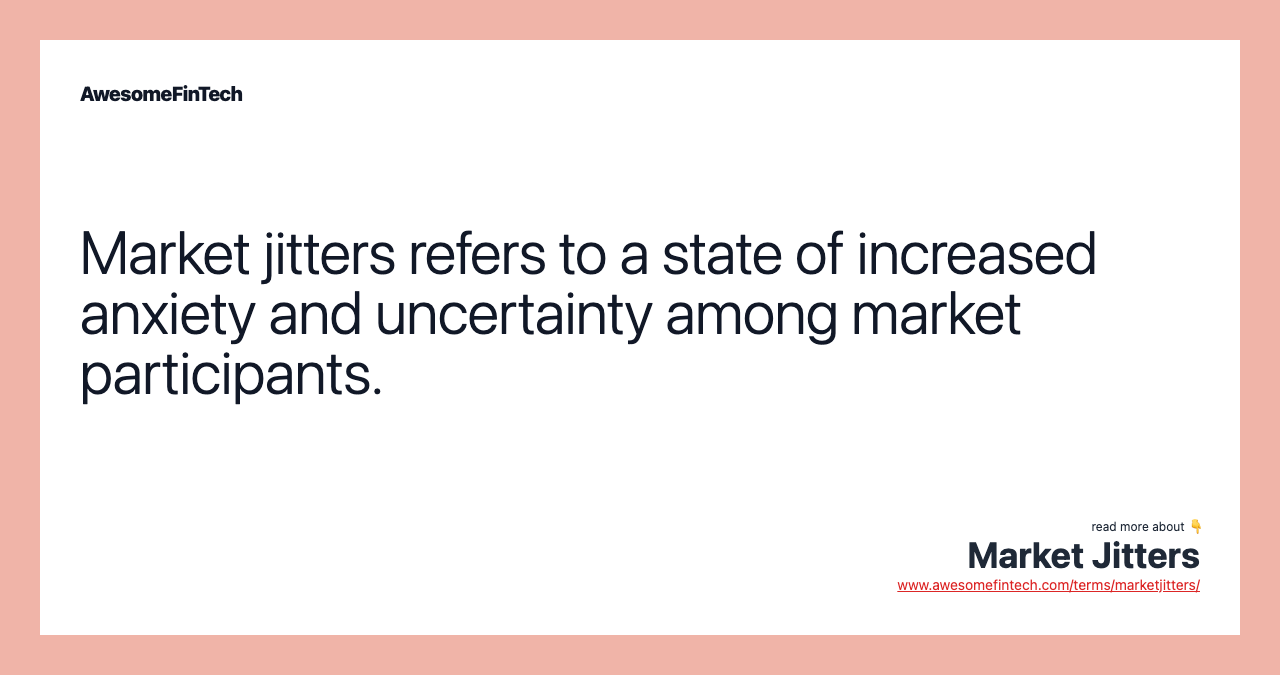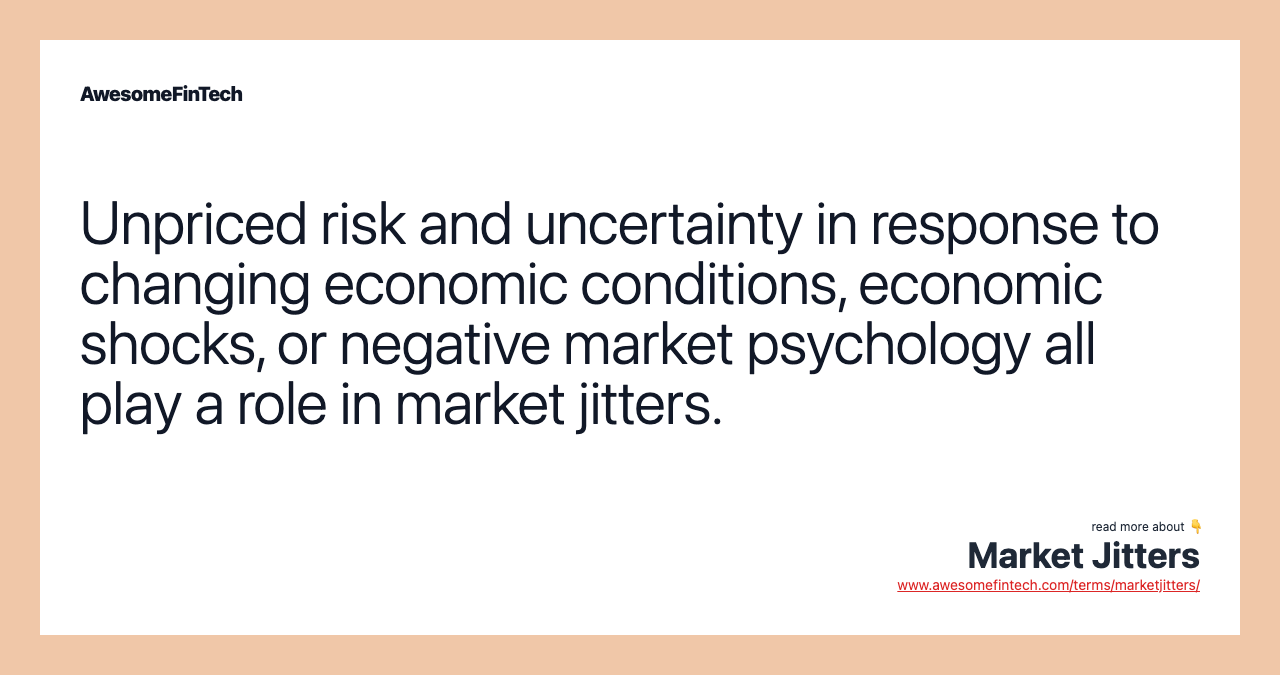Market Jitters
"Market jitters" is a colloquial term for an elevated state of anxiety and perceived uncertainty about the economy or a specific asset market. In the first half of 2018, the U.S. stock market experienced market jitters, because of fears that the Federal Reserve's interest rate hikes and quantitative tightening might quash the economic recovery, and trigger a sell-off in the bond market and the stock market. Unpriced risk and uncertainty in response to changing economic conditions, economic shocks, or negative market psychology all play a role in market jitters. Market jitters also tend to induce flights to safety in investments, where investors try to protect themselves from risk and uncertainty by moving into lower risk, lower return asset classes. During periods of market jitters, investments and trading strategies that are resilient to or benefit from market volatility may be advantageous.

More in Economy
What Are Market Jitters?
"Market jitters" is a colloquial term for an elevated state of anxiety and perceived uncertainty about the economy or a specific asset market.
Market jitters can be a sign that the stock market is overdue for a pullback or correction. This can lead to a repricing of risk or further degenerate into a significant economic downturn.



Understanding Market Jitters
Market jitters is a phrase associated with the turning point at the peak of a bull market or a stock market rally. This is usually when a negative economic shock, unexpectedly bad economic data, or poor corporate earnings reports increase market volatility. These events signal that there may be trouble in the financial markets.
When markets experience jitters it can be a sign they are overdue for a correction. Investors may reassess their portfolios and either consider shifts in tactical asset allocation, or rebalancing to bring their portfolios back to their desired strategic asset allocation. As risk is repriced, market jitters can lead to big flows into and out of different global asset classes.
As the saying goes, markets hate uncertainty. Market jitters often involve not only risk (known or estimable factors that can be priced in) but true uncertainty (unknown factors whose risk or probability cannot reliably estimated). Efficient markets may be able to handle risk well and adjust well to changing risk across various asset classes, but uncertainty is more difficult or impossible to accurately price.
Though uncertainty by its nature cannot be factored into prices, economists have devised ways to estimate the general perception of uncertainty in an economy. They use measures of asset price volatility, the dispersion of forecasts of economic performance among major forecasters, and the frequency of media mentions of terms related to uncertainty. Time periods when these measures are elevated can be considered episodes of market jitters.
Psychological factors often end up playing a role during periods of heightened uncertainty, which can lead to high volatility, dramatic price swings, and market instability. Keynesian economics refers to these types of factors as "animal spirits" due to their perceived irrationality. In a worst case scenario, a market may experience a setback purely as a result of market jitters, if the sentiment devolves into general pessimism.
During periods of market jitters, investments and trading strategies that are resilient to or benefit from market volatility may be advantageous. However, they may also fail dramatically if the investors guess wrong. Market jitters also tend to induce flights to safety in investments, where investors try to protect themselves from risk and uncertainty by moving into lower risk, lower return asset classes.
Example of Market Jitters
In the first half of 2018, the U.S. stock market experienced market jitters, because of fears that the Federal Reserve's interest rate hikes and quantitative tightening might quash the economic recovery, and trigger a sell-off in the bond market and the stock market.
Adding to their fears was the flattening of the yield curve and the sudden widening in the LIBOR-OIS spread, which is a measure of stress in the banking sector. The result of these market jitters was a big spike in the VIX, the CBOE Volatility Index for the S&P 500, otherwise known as the "fear index."
Related terms:
Animal Spirits
"Animal spirits" is a term used by economist John Maynard Keynes to explain how human emotions can drive financial decision-making in volatile times. read more
Bubble Theory
Bubble theory is a theory that markets occasionally push prices above their true values, leading to large or persistent overvaluations in asset prices read more
Bull Market : Characteristics & Examples
A bull market is a financial market in which prices are rising or are expected to rise. read more
Economics : Overview, Types, & Indicators
Economics is a branch of social science focused on the production, distribution, and consumption of goods and services. read more
Efficient Market Hypothesis (EMH)
The Efficient Market Hypothesis (EMH) is an investment theory stating that share prices reflect all information and consistent alpha generation is impossible. read more
Emotional Neutrality
Emotional neutrality is the concept of removing greed, fear, and other human emotions from financial or investment decisions. read more
Inflation
Inflation is a decrease in the purchasing power of money, reflected in a general increase in the prices of goods and services in an economy. read more
Keynesian Economics : History & Theory
Keynesian Economics is an economic theory of total spending in the economy and its effects on output and inflation developed by John Maynard Keynes. read more
Loss Aversion
Loss aversion in psychology refers to the emotional side of investing, namely the negative sentiment associated with recognizing a loss and its psychological effects. read more
Pullback and Example
A pullback refers to the falling back of a price of a stock or commodity from its recent pricing peak. read more